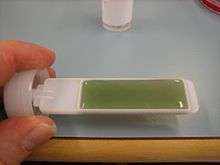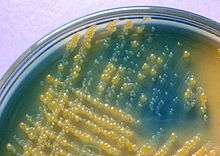Cystine–lactose–electrolyte-deficient agar
CLED agar (cystine–lactose–electrolyte-deficient agar or medium) is a valuable non-inhibitory growth medium used in the isolation and differentiation of urinary microbes. It contains cystine and lactose and is electrolyte-deficient; the latter trait prevents the swarming of Proteus species. Cystine promotes the formation of cystine-dependent dwarf colonies. Bromothymol blue is the indicator used in the agar, it changes to yellow in case of acid production during fermentation of lactose or changes to deep blue in case of alkalinization. Lactose-positive bacteria build yellow colonies. Bacteria which decarboxylate L-Cystine cause an alkaline reaction and build deep blue colonies[1]
| Peptone | 4g/l |
| 'Lab Lemco' powder | 3g/l |
| Tryptone | 4g/l |
| Lactose | 10g/l |
| L-Cystine | 128 mg/l |
| Bromothymol blue | 20 mg/l |
| Agar No. 1 | 15g/l |

A clear CLED agar plate after cultivation

Colonies of lactose and non-lactose fermenting bacteria on CLED agar
References
- Analytical, Fluka. "55420 CLED Agar (Cystine-Lactose-Electrolyte Deficient Agar; Bromothymol-blue Lactose Cystine Agar)" (PDF). Fluka Analytical. Retrieved 18 October 2014.
This article is issued from
Wikipedia.
The text is licensed under Creative
Commons - Attribution - Sharealike.
Additional terms may apply for the media files.